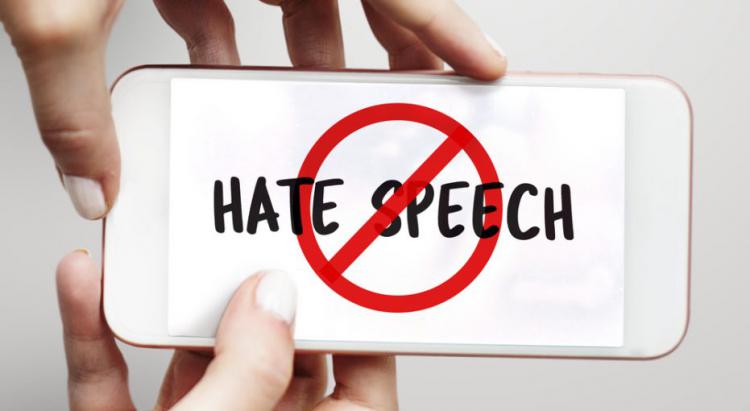
Monitoring of hate speech in Belarusian mass media: aims and methods
Monitoring team
Monitoring is carried out by volunteers of «Journalists for Tolerance» initiative group.
The monitoring idea and concept: Aleh Razhkou and Andrus Klikunou.
The monitoring methods / expert analysis: Violetta Yermakova.
Violetta Yermakova
- Master of Political Science (EHU, 2009), thesis on “Tolerance as a characteristic of the political culture of Belarusians”;
- Coordinator on the issues of gender at East European Network of the Peace Organizations (EENPO) of the Global Partnership for the Prevention of Armed Conflict (GPPAC);
- Jury member of the International Competition for the best publication on tolerance, integration, mutual respect and understanding in society, carried out by EENPO since 2010;
- Research and publications:
- “The Map of Tolerance”, 2011
- “Gender Educational Program” (parts 8 and 10), 2013
- “Tolerant Journalism”, 2013
- “The issue of the disabled people’s employment in the mirror of mass media”, 2014;
- Member of “Journalists for Tolerance” initiative group;
- ‘Radio Racyja’ correspondent.
Monitoring aim and objectives
The monitoring is aimed at assessing:
- the scope of widespread manifestations of hate speech in Belarusian mass media,
- the social groups it affects most of all;
- the categories of mass media with frequent manifestations of hate speech in Belarus (national /regional, state/ independent);
- the producers of hate speech in the media (the characters / the authors).
The monitoring data has been collected both for scientific and pragmatic reasons. The “Journalists for Tolerance” initiative members believe that the culture of creating ethic journalistic materials and the journalists’ feeling of social responsibility have significant development potential. And it is important to realize how this potential can be applied.
Various educational seminars and workshops on Ethic Journalism are regularly arranged in Belarus. The corresponding trainers require factual information on the most wide-spread manifestations of hate speech in Belarusian mass media to include them as illustrative cases in their presentations. Also, the trainers need to know for whom they should conduct such workshops, in order to have a noticeable effect in the national media field. Should the target group include journalists from the regions or the capital city, the employees of the state or independent mass media? Is it really important to work with journalists or do journalists only quote incorrect statements of their characters, being independent and unbiased themselves? Thus, the monitoring provides Ethical Journalism trainers and scholars with valuable information for their work.
On the other hand, the public importance of monitoring results is hard to overestimate.
Their publication helps to draw journalists’ attention to the topic of hate speech. The topic used to be marginal till the recent past. And it used to be discussed from the legal perspective, i.e. what publications can lead to suits against authors of arguable journalistic materials. The monitoring team made an attempt to shift the focus from the legal aspects to the ethic ones.
Any professional journalist possesses a bunch of refined and incredibly powerful communication tools. On the one hand, they can foster the increase of social tensions. On the other hand, they can contribute to resolving conflict situations.
The monitoring team decided to draw the media workers’ attention to this power and help them use it in smart and responsible ways.
Finally, the monitoring and its presentation are aimed at making the research visible for prospective monitors, who would like to join the team.
What is hate speech?
It is not the case, when somebody speaks badly about another person. If a person speaks up negatively about someone who has stolen a wallet or about an official taking a bribe, it shouldn’t be considered as hate speech. However, derogatory statements in relation to someone, caused by the ethnic origin, gender, age, or sexuality make distinct manifestations of hate speech.
In other words, hate speech is the communication practice that generates and perpetuates discrimination. And the term ‘discrimination’ is not taken in its legal meaning here, but in the meaning that has been introduced in social studies and psychology. The significant difference is that lawyers, when talking about discrimination, view its outer side, the committed acts. Sociologists and psychologists pay attention to the internal conditions of behavior (attitudes, beliefs, stereotypes). Thus, in our understanding not only calls for actions (for example, to deprive someone of the right to education) are regarded as manifestations of hate speech, but also the spreading of negative stereotypes, the formation of negative images of social groups (e.g., describing them as unable to learn etc.) are considered this way.
Why is it important to investigate hate speech? The monitoring team believes in Sapir-Whorf hypothesis, according to which language determines our thinking. And then thinking determines behavior. Here is an example: an employer does not employ a Roma (discrimination, behavior), because he thinks «Gypsies are prone to theft» (thinking), and he thinks so because he gets the idea of a Roma from the media, where they are consistently mentioned in criminal chronicle (communication practice). Change of communication practice leads to change of attitudes (it’s a slow process, we should admit), and as a result of attitude change the probability of discrimination decreases.
So, at their discretion and according to their awareness, journalists can create a picture of the world in which the probability of discrimination in relation to a particular social group either increases or decreases. In fact, mass media have power to program the world of tomorrow to a certain extent. And the objective of our initiative group is to draw the journalists’ attention to the ‘magic wand’ in their hands.
Selection of monitoring data
It looks like this: six volunteers (not experts in hate speech, just journalists who have completed a special training course) read mass media Web-sites, select the journalistic materials that have manifestations of hate speech (the monitors have a list of such manifestations), and fill out the form that can be found at the end of this document. Then the collected materials are gathered together and checked by the person responsible for the monitoring methods and expert analysis.
There were analyzed 36 Belarusian media within the reporting period (see. Appendix No.1. List of mass media). The media had been chosen randomly.
Selection criteria: the monitored media outlets mainly deal with social and political problematic and have regularly updated Web-sites. The latter is a purely technical limitation, simplifying information processing. 2/3 of monitored media outlets are nationwide with broad audience and 1/3 of monitored media outlets are regional. The latter have been taken to see if there might be any difference in their performance in comparison with nationwide periodicals. A half of the monitored media are owned by the state. The other half of monitored media are independent.
The monitoring team agreed not to limit themselves to newspapers. Therefore, the Web-sites of some prominent TV and radio broadcasters were included into the list of monitored media, too.
The monitoring team was criticized by some fellow journalists for the ‘unrepresentative selection’ of materials. The critics claimed that the monitoring subjects did not make a miniature model of Belarusian media field. The monitors would be happy to learn the existing models of Belarusian media field, and it is likely that the team will be able to use them to improve the conducted research. Presently, the selection is done in an extremely simplified manner. However, it is quite sufficient for meeting the initially set objectives. (see above — «Monitoring aim and objectives» section).
The problem with the selection criticizing, in the monitors’ opinion, is not connected with the degree of representativeness, but in the fact that ‘the anti-rating list’ (i.e. a list of publications with hate speech) is published in the monitoring report. The criticizing journalists claimed that even harsher publications could be found in the media that didn’t enter the monitoring list.
The monitoring team admitted fair criticism and discussed ways to avoid it in the future (e.g., through broadening the monitoring list and the monitoring team at the general stage of the hate speech monitoring in the future).
Monitoring data analysis
The collected data were gathered in one table and calculated (see Appendix No.3. The Monitoring Table.)
Where did the numbers come from? The monitors’ challenge was not just to collect a database of materials containing hate speech in 36 media under review. They also needed to compare materials to determine which of them was more or less correct. And they needed to bear in mind that they were written on different topics, in different genres, and finally, that they differed in size.
For the comparison to be made possible, the monitoring expert analyzed the manifestations of hate speech in each article in question. At this point the numbers appeared, as the expert assigned numerical values to them. The thing is that hate speech can be of a different degree of harshness. 3 points were assigned for the most severe manifestations (marked in bold font), 2 points – for the moderate (marked in italics), and 1 point (unmarked) — for minor manifestations of hate speech (see the monitoring form below).
There were taken three scales of ‘Hate Speech’ harshness in the monitoring research – ‘Sova’ Center’s scale, “Xenomonitor” initiative’s scale, and the monitoring expert’s original ‘Tolerance of article’ scale. The marks from all three scales were summed for each article in question to make a rating list of ‘hate speech’ harshness manifestation.
However, it was not enough to have an objective and clear picture, since hate speech could set the message of the whole material, and could appear once only by chance. Journalists could give incorrect citations or they could produce hate speech themselves. These factors had to be considered, too. Therefore, it was decided to apply the increasing and decreasing amendments to the numbers received at the first stage. They were reflected in the table below:
| Amendments | Factors that influenced the perception of hate speech by the audience |
| Increase by 1.3 times | Hate speech is typical of the whole material |
| Increase by 1.3 times | The journalist produces hate speech or shows solidarity with those who produce it |
| Increase by 1.2 times | Hate speech is common, but it does not capture all of the material |
| Increase by 1.2 times | The journalist doesn’t express his attitude to hate speech in the words of his characters or his attitude is contradictory |
| Increase by 1.1 times | Hate speech occurs no more than 3 times in the material |
| Decrease by 2 times | The journalist expresses a negative attitude towards hate speech |
Following the adjustment, the results for each monitored material under review could be compared to each other. (The monitoring team agreed to regard the figure as ‘the incorrectness indicator’.)
The results of these comparisons were published in the monitoring reports.
The monitoring doesn’t answer the following questions:
(1) We can’t say, if there’s «a lot» or «little» hate speech in the monitored Belarusian media.
To do this we should compare our results with the results of, for instance, neighboring countries. And for such a comparison to be valid, it is necessary that the monitoring is conducted in several countries according to completely identical procedures. It is beyond the monitoring team’s capabilities nowadays.
We can only say what sort of hate speech is found in the monitored Belarusian media and give its qualitative description in the Final Evaluation Report (see below).
(2) We can’t say if the use of hate speech has increased or decreased in the Belarusian mass media during the monitoring period. We can answer this question about those 36 media we’ve been monitoring, but definitely not about the whole country. The thing is that some journalists know that they are being monitored, and others know that they are not. And theoretically the observer’s effect could fire, since people tend to change their behavior to some extent, when observed.
(3) We can’t report on the percentage of hate speech containing publications. Technically, it was hard to do at the pilot stage. An interesting indicator could have appeared from this figure: the percentage of hate speech containing publications for different media. And mass media could be compared according to this indicator. We’re planning to include the marker at the general stage of ‘hate speech’ monitoring research in the future.
The questions our monitoring research gives answers to…
…are reflected in our reports (see Final Evaluation Report below).
The monitoring form
| No. | |
| Name of the article | |
| Date of publication | |
| Author | |
| Link | |
| Genre (one answer only) |
|
| Hate speech location within the material (any answer option) |
|
| Intensity of hate speech in the material (one answer) |
|
| Subject of HS (one answer) |
|
| Subject of HS: characters (if points 1 and 3 marked in the previous question) |
|
| The names and positions of the characters (if in the question about the subject first and third options were selected) | |
| The author’s attitude to HS (one answer) |
|
| Signs of selecting hate speech objects (all possible answers) |
|
| The image formed by HS in the reader’s mind (all possible answers) |
|
| Type of HS (the scale by “Sova” centre) |
|
| Types of HS (the scale by “Xenomonitor” initiative) |
|
| Tolerance of the article |
|





